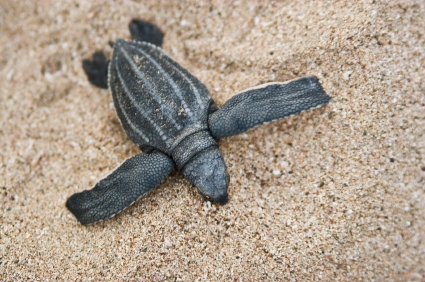 Let me start out by saying: I love sea turtles. I can’t explain why, but they fascinate me. I have sweatshirts, bags and artwork with sea turtles on them. I even make jewelry with sea turtle themes. Ask anyone who knows me; I have a thing for sea turtles. So when I came across the article “Tracking leatherback turtles from the world’s largest rookery: Assessing threats across the South Atlantic” in the Proceedings of the Royal Society B (1), all thoughts of writing about anything else were readily dismissed. How could I NOT write about leatherback sea turtles?
Let me start out by saying: I love sea turtles. I can’t explain why, but they fascinate me. I have sweatshirts, bags and artwork with sea turtles on them. I even make jewelry with sea turtle themes. Ask anyone who knows me; I have a thing for sea turtles. So when I came across the article “Tracking leatherback turtles from the world’s largest rookery: Assessing threats across the South Atlantic” in the Proceedings of the Royal Society B (1), all thoughts of writing about anything else were readily dismissed. How could I NOT write about leatherback sea turtles?
There are all sorts of reasons to love these creatures. Take for example the contradiction of how awkward and slow they are on land, and how graceful they are in the water. (Still, the same could be said of sea lions and I can’t say that I have ever been inspired by them). No, what fascinates me so much about sea turtles is their ability to swim hundreds, even thousands, of miles through the open ocean and still return years later to the same beach they hatched on to lay their own eggs. Yes, I know they are not the only animal that makes these kinds of journeys, but how many swim through the open sea? It is like they are born with a natural GPS system. And that is pretty darn cool if you ask me.
Leatherback turtles (Dermochelys coriacea ) are the only living member of the Family Dermochelyidae and genus Dermochelys. They do not have a hard shell but instead their backs are covered with a leathery skin strengthened by thousands of tiny bone plates. D. coriacea are listed as Critically Endangered (facing an extremely high risk of extinction in the wild in the immediate future) by the International Union for Conservation of Nature and Natural Resources.
Although leatherback turtles lay their eggs on land, they spend a large portion of their lives in the ocean, and can travel long distances as they forage for food. This makes them extremely difficult to study. The largest leatherback breeding colony in the world is located in Gabon, Central Africa. Ironically it is the migration patterns from this, the largest rookery that we know the least about. To address this, Matthew Witt and his associates set about tracking 25 adult leatherback females from the Gabon rookery through the South Atlantic using satellite telemetry.
The results of Witt et al. illustrate some of the challenges that conservationists face as they try to save these creatures. The turtles from the Gabon rookery followed three different migratory paths. One was a 4,699 mile swim straight across the South Atlantic to South America. The other two routes involved long treks to either the waters off Southern Africa or the equatorial Atlantic. The equatorial Atlantic migration showed the highest density, suggesting that these waters may be of particular importance to the survival of this species. The area in the equatorial Atlantic region traversed by the turtles is also one of the most densely fished longline fishery areas in the world. Although the equatorial route showed the greatest danger, all three of the routes identified with this study pass through areas with significant risk from longline fishing fleets and other anthropogenic threats.
With the turtles spending so much time on the high seas, it is clear that conservation efforts can not be one dimensional, but must encompass nesting beaches as well as feeding areas and migration routes. The turtles followed in this study passed through the waters of at least 11 countries. Add to that the countries who have longline fishing fleets operating in any of the migration paths, and the number of countries that must be involved in the conservation effort could be quite a few more.
These ancient mariners have swum the seas for longer than humans have been braving the waves, and now their fate depends upon how well we can coordinate conservation efforts between multiple countries and across different geographical areas. The leatherback sea turtle is the last of a Family (Dermochelyidae) and a Genus (Dermochelys). Can what we learned through satellite tracking help save them? I hope so.
Reference
- Witt MJ, Augowet Bonguno E, Broderick AC, Coyne MS, Formia A, Gibudi A, Mounguengui Mounguengui GA, Moussounda C, Nsafou M, Nougessono S, Parnell RJ, Sounguet GP, Verhage S, & Godley BJ (2011). Tracking leatherback turtles from the world’s largest rookery: assessing threats across the South Atlantic. Proceedings. Biological sciences / The Royal Society PMID: 21208949

Design a poster to educate your peers and friends on the theme
‘SAVE FISH / SAVE TURTLE’
Reference-The Emirates Wildlife Society, in Association with the World Wide Fund for Nature (EWS-WWF), are launched -‘Choose Wisely’ campaign to raise awareness of the need to replace overfished local species with more environment-friendly options.
Seven types of UAE fish such as the hammour and kingfish face the risk of extinction. About 81 per cent of the world’s main fish stocks are currently considered fully exploited and depleted.
The campaign’s main goal is to address the impact of overfishing in the UAE and on the environment)